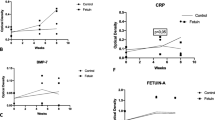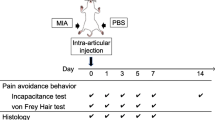Abstract
To study the establishment of adjuvant-induced osteoarthritis of the lumbar facet joint in a rat model. Complete Freund’s adjuvant (experimental group) and saline (control group) were randomly injected into the right and left side of rat, respectively. The rats were killed, and degeneration of lumbar facet joint was evaluated at macroscopic level and scored based on OARSI scores system. Moreover, Interleukin-1β and tumor necrosis factor-α levels in the synovium were measured. The macroscopic scores and OARSI scores of experimental group were higher than the control group (P < 0.05). The concentration of tumor necrosis factor-α was significantly increased only on 3- and 7-day post-surgery when compared with controls, and interleukin-1β was increased on days 3,7 and 14 post-surgery (P < 0.05). The rat model of adjuvant can induce degeneration of the lumbar facet joint. It can be useful for studies on mechanisms and treatment of lumbar facet joint osteoarthritis.

Similar content being viewed by others
References
Beresford, Z. M., Kendall, R. W., & Willick, S. E. (2010). Lumbar facet syndromes. Current Sports Medicine Reports, 9(1), 50–56.
Boswell, M. V., et al. (2003). Accuracy of precision diagnostic blocks in the diagnosis of chronic spinal pain of facet or zygapophysial joint origin. Pain Physician, 6(4), 449–456.
Smith, H. S., Colson, J., & Sehgal, N. (2013). An update of evaluation of intravenous sedation on diagnostic spinal injection procedures. Pain Physician, 16(2 Suppl), SE217–SE228.
Park, K. D., et al. (2013). Effect of medial branch block in chronic facet joint pain for osteoporotic compression fracture: One year retrospective study. Annals of Rehabilitation Medicine, 37(2), 191–201.
Schwarzer, A. C., et al. (1994). Clinical features of patients with pain stemming from the lumbar zygapophysial joints. Is the lumbar facet syndrome a clinical entity? Spine (Phila Pa 1976), 19(10), 1132–1137.
Sehgal, N., et al. (2007). Systematic review of diagnostic utility of facet (zygapophysial) joint injections in chronic spinal pain: An update. Pain Physician, 10(1), 213–228.
Pampati, S., Cash, K. A., & Manchikanti, L. (2009). Accuracy of diagnostic lumbar facet joint nerve blocks: A 2-year follow-up of 152 patients diagnosed with controlled diagnostic blocks. Pain Physician, 12(5), 855–866.
Koo, S. T., et al. (2013). The effects of pressure on arthritic knees in a rat model of CFA-induced arthritis. Pain Physician, 16(2), E95–E102.
Chang, M., et al. (2010). Evaluation of phenoxybenzamine in the CFA model of pain following gene expression studies and connectivity mapping. Molecular Pain, 6, 56.
Wlodarski, K. H., & Dickson, G. R. (2002). Evaluation of locally induced osteoarthritis by the complete and incomplete Freund’s adjuvant in mice. The application of DEXA measurements. Folia Biologica (Praha), 48(5), 192–199.
Chung, J. I., et al. (2012). Anti-inflammatory effect of low intensity ultrasound (LIUS) on complete Freund’s adjuvant-induced arthritis synovium. Osteoarthritis Cartilage, 20(4), 314–322.
Rutten, K., et al. (2014). Pharmacological validation of a refined burrowing paradigm for prediction of analgesic efficacy in a rat model of sub-chronic knee joint inflammation. European Journal of Pain, 18(2), 213–222.
Yang, C. H., et al. (2013). Pulsed radiofrequency treatment attenuates increases in spinal excitatory amino acid release in rats with adjuvant-induced mechanical allodynia. NeuroReport, 24(8), 431–436.
Pelletier, J. P., et al. (1998). Reduced progression of experimental osteoarthritis in vivo by selective inhibition of inducible nitric oxide synthase. Arthritis and Rheumatism, 41(7), 1275–1286.
Pritzker, K. P., et al. (2006). Osteoarthritis cartilage histopathology: Grading and staging. Osteoarthritis Cartilage, 14(1), 13–29.
Yeh, T. T., et al. (2008). Intra-articular injection of collagenase induced experimental osteoarthritis of the lumbar facet joint in rats. European Spine Journal, 17(5), 734–742.
Yeh, T. T., et al. (2007). The short-term therapeutic effect of recombinant human bone morphogenetic protein-2 on collagenase-induced lumbar facet joint osteoarthritis in rats. Osteoarthritis Cartilage, 15(12), 1357–1366.
Adaes, S., et al. (2014). Intra-articular injection of collagenase in the knee of rats as an alternative model to study nociception associated with osteoarthritis. Arthritis Research and Therapy, 16(1), R10.
Kim, B. J., et al. (2013). Establishment of a reliable and reproducible murine osteoarthritis model. Osteoarthritis Cartilage, 21(12), 2013–2020.
Cohen-Solal, M., Funck-Brentano, T., & Hay, E. (2013). Animal models of osteoarthritis for the understanding of the bone contribution. Bonekey Reports, 2, 422.
Teeple, E., et al. (2013). Animal models of osteoarthritis: Challenges of model selection and analysis. The AAPS Journal, 15(2), 438–446.
Hashizume, M., et al. (2010). High molecular weight hyaluronic acid relieved joint pain and prevented the progression of cartilage degeneration in a rabbit osteoarthritis model after onset of arthritis. Modern Rheumatology, 20(5), 432–438.
Yu, B., et al. (2011). Effect of intra-articular ozone injection on serum and synovial TNF-alpha, TNFR I, and TNFR II contents in rats with rheumatoid arthritis. Nan Fang Yi Ke Da Xue Xue Bao = Journal of Southern Medical University, 31(6), 1055–1058.
Pedersen, D. R., et al. (2013). Comparative digital cartilage histology for human and common osteoarthritis models. Orthopedic Research and Reviews, 2013(5), 13–20.
Kim, J. S., et al. (2011). Characterization of a new animal model for evaluation and treatment of back pain due to lumbar facet joint osteoarthritis. Arthritis and Rheumatism, 63(10), 2966–2973.
Gong, K., et al. (2011). Rat model of lumbar facet joint osteoarthritis associated with facet-mediated mechanical hyperalgesia induced by intra-articular injection of monosodium iodoacetate. Journal of the Formosan Medical Association, 110(3), 145–152.
Henry, J. L., et al. (2012). Lumbar facet joint compressive injury induces lasting changes in local structure, nociceptive scores, and inflammatory mediators in a novel rat model. Pain Research and Treatment, 2012, 127636.
Li, L., Zhou, Z., & Zeng, J. (2007). Expression of receptor activator of nuclear factor -KB ligand (RANKL) of synovium in adjuvant arthritis rats and effects of sodium arsenite on them. Zhongguo GU Shang = China Journal of Orthopaedics and Traumatology, 20(5), 292–294.
Tachihara, H., et al. (2007). Does facet joint inflammation induce radiculopathy?: An investigation using a rat model of lumbar facet joint inflammation. Spine (Phila Pa 1976), 32(4), 406–412.
Igarashi, A., Kikuchi, S., & Konno, S. (2007). Correlation between inflammatory cytokines released from the lumbar facet joint tissue and symptoms in degenerative lumbar spinal disorders. Journal of Orthopaedic Science: Official Journal of the Japanese Orthopaedic Association, 12(2), 154–160.
Xu, F., et al. (2014). Complete Freund’s adjuvant-induced acute inflammatory pain could be attenuated by triptolide via inhibiting spinal glia activation in rats. Journal of Surgical Research, 188(1), 174–182.
Sugimoto, Y., et al. (2013). K-685, a TRPV1 antagonist, blocks PKC-sensitized TRPV1 activation and improves the inflammatory pain in a rat complete Freund’s adjuvant model. Journal of Pharmacological Sciences, 123(3), 256–266.
Kalichman, L., & Hunter, D. J. (2007). Lumbar facet joint osteoarthritis: A review. Seminars in Arthritis and Rheumatism, 37(2), 69–80.
Acknowledgments
This work was supported by the National Natural Science Foundation of China (No. 81071514).
Author information
Authors and Affiliations
Corresponding authors
Additional information
Feng Shuang, Jialiang Zhu and Keran Song have contributed equally to this study.
Rights and permissions
About this article
Cite this article
Shuang, F., Zhu, J., Song, K. et al. Establishment of a Rat Model of Adjuvant-Induced Osteoarthritis of the Lumbar Facet Joint. Cell Biochem Biophys 70, 1545–1551 (2014). https://doi.org/10.1007/s12013-014-0091-5
Published:
Issue Date:
DOI: https://doi.org/10.1007/s12013-014-0091-5




